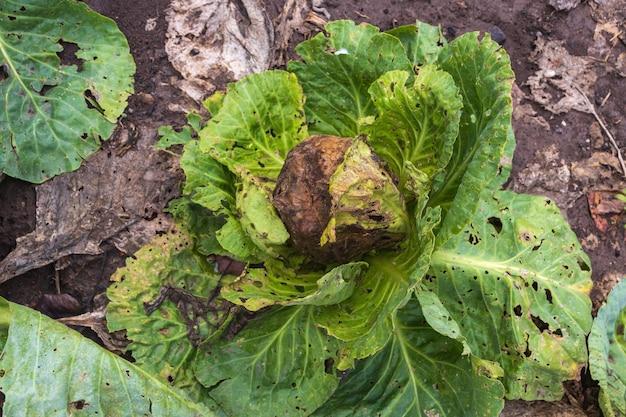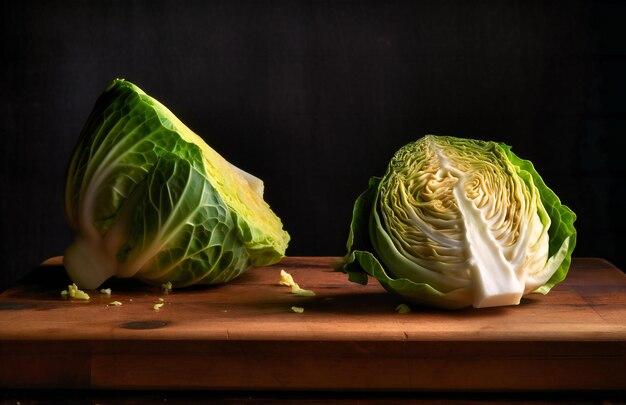Cabbage is a versatile and nutritious vegetable that is commonly used in various dishes around the world. However, when you cut into a cabbage and notice it turning black, it can be quite alarming and may leave you wondering what went wrong. In this blog post, we will explore the reasons behind why cut cabbage turns black and address some common questions related to this issue.
One of the main causes of black discoloration on cut cabbage is a condition known as black rot. This bacterial disease affects cabbage plants and can lead to the development of black spots or streaks on the leaves and stems. When you cut into an infected cabbage, the affected areas may turn black, indicating the presence of the disease. It is important to note that consuming cabbage with black rot is not recommended, as it can affect the taste and quality of the vegetable.
In addition to exploring the reasons behind the blackening of cut cabbage, we will also delve into other related topics such as the shelf life of fresh cabbage, proper storage methods after cutting, signs of rotten cabbage, and potential health risks associated with consuming old or moldy cabbage. So, let’s dive in and unravel the mysteries behind why cut cabbage turns black and what it means for your next meal.
Why Does Cut Cabbage Turn Black
The Science Behind the Color Change
Have you ever wondered why your once vibrant and crisp cut cabbage turns into a disconcerting shade of black? Don’t worry, you’re not alone! This common phenomenon that often leaves cabbage lovers puzzled has a scientific explanation.
When you cut cabbage, its cells are exposed to air, specifically to oxygen. This triggers a process called oxidation, where the oxygen reacts with certain compounds in the cabbage, causing a chemical reaction. One of the compounds affected is called anthocyanin, which is responsible for the cabbage’s natural red or purple hue.
Cabbage’s “Dark Side”
As the oxidation process unfolds, the anthocyanin in the cabbage undergoes a transformation. Instead of maintaining its vibrant color, it turns dark—not quite black, but definitely not the royal purple you’d expect. It’s like the cabbage has unveiled its “dark side,” much to our dismay.
But Why Does It Happen
The oxidation of anthocyanin not only alters its color but also affects its chemical structure. This structural change leads to a shift in the way light is absorbed and reflected by the cabbage. As a result, the cabbage appears darker to our eyes.
Think of the anthocyanin as a chameleon that changes its disguise, but instead of blending into its surroundings, it takes on a less visually pleasing shade. And this is where the humor in the whole situation lies—Nature’s way of adding a touch of unexpected darkness to our cabbage-loving lives.
How to Prevent Blackening
Now that we’ve unraveled the mystery of why cut cabbage turns black, it’s time to explore some preventive measures. One option is to minimize the cabbage’s exposure to air as much as possible. This can be done by wrapping the cut edges tightly with plastic wrap or storing the cabbage in an airtight container.
Additionally, you can slow down the oxidation process by refrigerating the cut cabbage. The colder temperature slows down chemical reactions, including the oxidation of anthocyanin. So pop that cabbage in the fridge, and you’ll have a better chance of preserving its vibrant purple hue.
Embrace the Dark Side
Even though the sight of blackened cabbage may initially put a damper on your culinary aspirations, remember that taste is what truly matters. The onset of a darker color doesn’t affect the flavor or nutritional value of the cabbage.
So, next time you encounter cut cabbage turning black, put on your adventurous spirit and embrace the darker side of this cruciferous vegetable. Besides, a little unexpected darkness can make our culinary experiences all the more interesting!
Knowing the science behind why cut cabbage turns black helps demystify this common occurrence. The oxidation of anthocyanin, triggered by exposure to oxygen, is the culprit behind the cabbage’s color change. By understanding the causes and implementing preventive measures, such as minimizing air exposure and refrigeration, we can better preserve the cabbage’s vibrant color. So, let’s not judge a cabbage by its color and instead focus on the flavorful and nutritious benefits it offers, even when its hue takes a darker turn.
FAQ: Why Does Cut Cabbage Turn Black
Can you eat cabbage with black rot
Yes, you can eat cabbage with black rot, but you may want to think twice before doing so. While black rot doesn’t pose a significant health risk, it can affect the taste and texture of the cabbage. It’s best to discard any portions that are heavily affected by black rot and only consume the unaffected parts.
What is the black on cut cabbage
The black on cut cabbage is most likely the result of a condition known as black rot. Black rot is a bacterial disease that affects cruciferous vegetables like cabbage. The bacteria enter through wounds or natural openings, causing black discoloration and decay. It can be detected by the dark veins extending from the cut edges of the cabbage.
How long can you keep fresh cabbage in the fridge
Fresh cabbage can be stored in the fridge for up to two weeks. To ensure optimal freshness and taste, it’s recommended to use it within the first week. However, if the cabbage shows signs of spoilage or has black rot, it’s best to discard it.
Should cabbage be refrigerated
Yes, cabbage should be refrigerated to maintain its freshness for a longer duration. Storing cabbage in the refrigerator helps slow down the deterioration process and keeps it crisp. Make sure to wrap the cabbage tightly in plastic wrap or store it in a sealed bag to prevent moisture loss.
How long does a cut cabbage last
A cut cabbage can last for about 4-7 days if stored properly in the refrigerator. However, it’s important to note that the quality and texture can deteriorate over time. To make the most of your cut cabbage, it’s best to consume it within the first few days of cutting.
How do you store cabbage after cutting
After cutting cabbage, store it in a sealed plastic bag or airtight container in the refrigerator. Make sure to remove any outer leaves that may have started to wilt or show signs of rot. Proper storage will help keep the cabbage fresh and prevent it from absorbing odors from other foods in the fridge.
What is rotten cabbage
Rotten cabbage refers to cabbage that has undergone advanced decay. It will have a foul smell, a slimy texture, and often display discoloration or mold growth. Consuming rotten cabbage is not recommended as it may lead to foodborne illnesses.
Is cabbage toxic
No, cabbage is not toxic. In fact, it is a highly nutritious vegetable packed with vitamins, minerals, and fiber. However, consuming cabbage with black rot or signs of spoilage may not be enjoyable due to changes in taste, texture, and odor.
Is black on cabbage okay to eat
Although the black on cabbage may not look appealing, it is generally safe to eat in small quantities. However, for the best eating experience, it is recommended to remove the affected parts and only consume the healthy portions of the cabbage.
What is cabbage disease
Cabbage disease encompasses a variety of diseases that can affect cabbage plants, including black rot, clubroot, and fusarium wilt. These diseases are caused by bacteria or fungi and can result in black discoloration, decay, stunted growth, or overall plant decline. Proper crop management and preventive measures can help control these diseases.
Can you get sick from eating old cabbage
Eating old cabbage may increase your risk of foodborne illnesses, especially if it has started to show signs of spoilage or rot. To avoid any health issues, it’s best to consume fresh cabbage and check for any visible signs of decay before eating.
What does rotten cabbage smell like
Rotten cabbage has a distinct foul odor that is difficult to miss. It may smell putrid or sulfur-like, often indicating advanced decay and the presence of harmful bacteria. If you encounter this smell, it’s best to dispose of the cabbage immediately.
Can you eat cabbage that has turned brown
Cabbage that has turned brown is a sign of deterioration and may indicate that the cabbage is past its prime. While it may not necessarily be harmful to consume small portions of browned cabbage, the taste and quality will likely be compromised. It’s best to use fresh cabbage for the most enjoyable culinary experience.
Can cabbage get moldy
Yes, cabbage can develop mold under certain conditions. Mold growth may occur if the cabbage becomes overly moist or is stored in high humidity. Moldy cabbage should be discarded, as it can produce harmful mycotoxins that may cause illness if consumed.
How do you control black rot in cabbage
To prevent and control black rot in cabbage, follow these practices:
- Purchase healthy seedlings from reputable sources.
- Promote good air circulation and proper spacing between plants.
- Avoid excessive watering, as moisture can encourage bacterial growth.
- Remove and destroy any infected plants or plant parts promptly.
- Practice crop rotation to prevent the build-up of bacteria in the soil.
- Sanitize tools, containers, and surfaces to prevent the spread of bacteria.
Why does cut cabbage turn gray
Cut cabbage can turn gray due to oxidation. When cabbage is exposed to air, enzymes within the vegetable react with oxygen, leading to discoloration. While this gray color change doesn’t necessarily indicate spoilage, it’s best to consume the cabbage before it loses its freshness and appeal.
How can you tell if cabbage has gone bad
To determine if cabbage has gone bad, look for these signs:
- Foul or off-putting odor
- Slimy or wilted leaves
- Discoloration, mold, or signs of decay
- Unpleasant taste or texture
If any of these signs are present, it’s advisable to discard the cabbage to avoid any potential foodborne illness.

